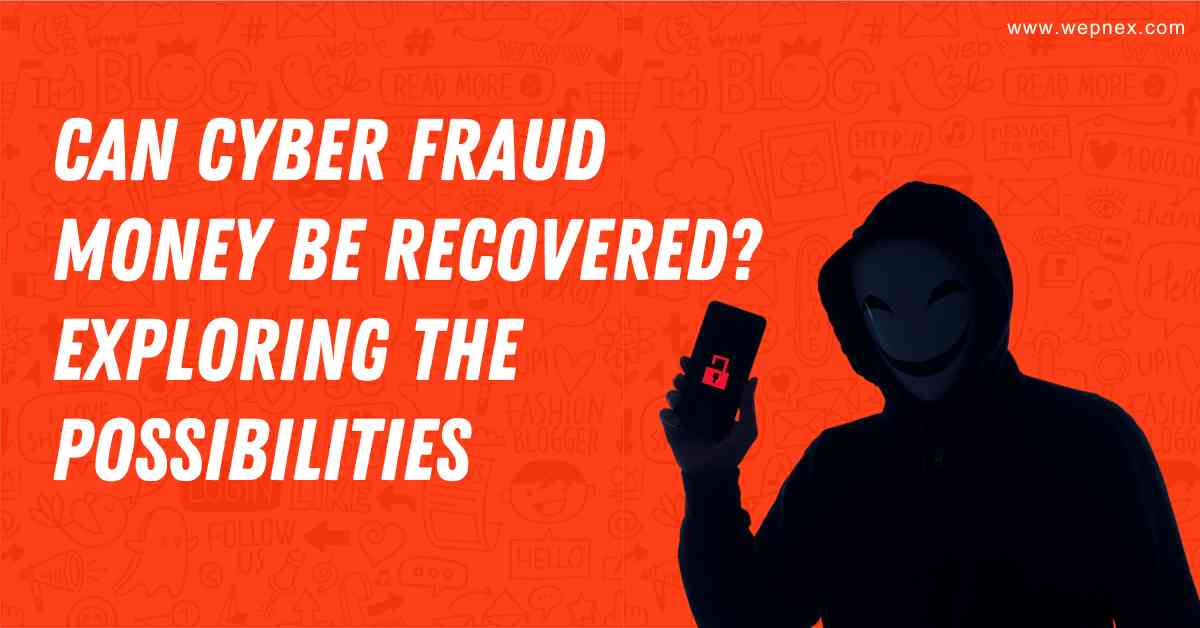Introduction
Cyber Fraud
In today’s digital age, the world is more connected than ever before. While this connectivity brings numerous benefits, it also exposes individuals and organizations to various cyber threats, including cyber fraud. Cyber fraud encompasses a wide range of illegal activities conducted online with the intent to deceive or steal from victims. One of the most pressing questions in the realm of cyber fraud is whether the money lost to these fraudulent activities can be recovered. In this comprehensive guide, we will explore the possibilities of recovering money lost to cyber fraud, step by step, and address five frequently asked questions on the topic.
Table of Contents
- Understanding Cyber Fraud
- 1.1 What is Cyber Fraud?
- 1.2 Common Types of Cyber Fraud
- 1.3 How Do Cybercriminals Operate?
- The Challenges of Recovering Stolen Funds
- 2.1 Legal and Jurisdictional Complexities
- 2.2 Anonymity of Cybercriminals
- 2.3 Rapid Movement of Funds
- 2.4 Limited Resources and Expertise
- 2.5 International Cooperation
- Steps to Recover Cyber Fraud Money
- 3.1 Immediate Actions
- 3.2 Reporting the Crime
- 3.3 Legal and Law Enforcement Involvement
- 3.4 Contacting Financial Institutions
- 3.5 Engaging Cybersecurity Experts
- 3.6 Pursuing Civil Litigation
- Frequently Asked Questions
- 4.1 Can all cyber fraud money be recovered?
- 4.2 What is the role of law enforcement agencies in recovering stolen funds?
- 4.3 How can cybersecurity experts assist in the recovery process?
- 4.4 Is it possible to trace cryptocurrencies used in cyber fraud?
- 4.5 What preventive measures can individuals and organizations take?
- Conclusion
1. Understanding Cyber Fraud
Before delving into the possibilities of recovering money lost to cyber fraud, it’s crucial to understand the nature of cyber fraud itself.
1.1 What is Cyber Fraud?

Cyber fraud refers to any fraudulent activity conducted online with the aim of deceiving individuals or organizations and extracting money, sensitive information, or assets. This type of fraud encompasses a wide range of techniques and schemes, including phishing, identity theft, advance-fee fraud, online scams, and more. Cybercriminals often use deception, social engineering, and malicious software to perpetrate these crimes.
1.2 Common Types of Cyber Fraud
Cyber fraud comes in various forms, some of which include:
- Phishing: Cybercriminals send deceptive emails or messages to trick recipients into revealing sensitive information, such as login credentials or financial details.
- Identity Theft: Criminals steal personal information, such as Social Security numbers or credit card details, to impersonate individuals for financial gain.
- Advance-Fee Fraud: Victims are promised significant rewards or financial gains in exchange for a small upfront fee, only to find that the promised rewards do not materialize.
- Ransomware: Malicious software encrypts a victim’s data, and a ransom is demanded in exchange for the decryption key.
- Investment and Ponzi Schemes: Scammers lure victims into fake investment opportunities, promising high returns but ultimately disappearing with the invested funds.
1.3 How Do Cybercriminals Operate?
Cybercriminals often operate anonymously, using techniques like Tor networks and cryptocurrency transactions to conceal their identities and evade law enforcement. They exploit vulnerabilities in software and networks, exploit human weaknesses through social engineering, and frequently operate across international borders. These factors make it challenging to trace and apprehend cybercriminals, as well as recover stolen funds.
2. The Challenges of Recovering Stolen Funds
Recovering money lost to cyber fraud is a complex and challenging process. Several factors contribute to these challenges:
2.1 Legal and Jurisdictional Complexities
Cybercrime operates across national borders, and the laws and jurisdictions involved can be convoluted. What may be illegal in one country might not be in another. This complicates the process of pursuing cybercriminals and recovering stolen funds.
2.2 Anonymity of Cybercriminals
Cybercriminals often go to great lengths to hide their identities, using pseudonyms and anonymizing technologies. This anonymity makes it difficult for law enforcement agencies to track them down.
2.3 Rapid Movement of Funds
Once stolen, funds can be quickly moved through various accounts, including offshore ones, making it challenging to trace and freeze the assets.
2.4 Limited Resources and Expertise
Many law enforcement agencies and organizations lack the resources and expertise required to investigate cyber fraud cases thoroughly.
2.5 International Cooperation
Coordinating efforts between different countries and jurisdictions is often necessary in cybercrime investigations. This can be a slow and complex process, hampering recovery efforts.
3. Steps to Recover Cyber Fraud Money
Recovering money lost to cyber fraud is a multi-faceted process that involves various stakeholders and steps. Here is a step-by-step guide to help victims navigate the recovery process:
3.1 Immediate Actions
If you suspect you’ve fallen victim to cyber fraud, take the following immediate actions:
- Disconnect: Isolate compromised devices from the internet to prevent further damage.
- Change Passwords: Change passwords for all affected accounts, including email, financial, and social media accounts.
- Report: Report the incident to the appropriate authorities and organizations, such as local law enforcement, the Indian Cyber Crime Department (for Indian. residents), and the affected financial institution.
3.2 Reporting the Crime
Reporting the cybercrime is essential as it initiates the investigative process. Provide as much detail as possible, including the nature of the fraud, the amounts involved, and any evidence you have gathered.
National Cyber Crime Reporting Portal
3.3 Legal and Law Enforcement Involvement
Engage with law enforcement agencies that specialize in cybercrime. They can assess the situation and determine if a criminal investigation is warranted. Be prepared to provide all relevant information and evidence.
3.4 Contacting Financial Institutions
If financial transactions are involved, immediately contact your bank or financial institution to report the fraud. They may be able to freeze or reverse transactions, depending on the circumstances.
3.5 Engaging Cybersecurity Experts
Consider hiring cybersecurity experts who specialize in digital forensics and cybercrime investigations. They can help trace the cybercriminal’s digital footprints, gather evidence, and assist law enforcement in the investigation.
3.6 Pursuing Civil Litigation
In addition to criminal proceedings, victims may also pursue civil litigation against the perpetrators. This can lead to court-ordered restitution if the cybercriminal is apprehended and convicted.
4. Frequently Asked Questions
Let’s address some of the most frequently asked questions regarding the recovery of money lost to cyber fraud:
4.1 Can all cyber fraud money be recovered?
Unfortunately, not all cyber fraud money can be recovered. The chances of recovery depend on various factors, including the type of fraud, the speed of detection and reporting, the cooperation of financial institutions, and the effectiveness of law enforcement efforts.
4.2 What is the role of law enforcement agencies in recovering stolen funds?
Law enforcement agencies play a crucial role in investigating cyber fraud and pursuing cybercriminals. They may work with international counterparts to track down perpetrators and recover stolen funds through legal means.
4.3 How can cybersecurity experts assist in the recovery process?
Cybersecurity experts can assist by conducting digital forensics to trace the origin of the cyberattack, identify the perpetrator, and gather evidence that can be used in legal proceedings. Their expertise is valuable in building a case against cybercriminals.
4.4 Is it possible to trace cryptocurrencies used in cyber fraud?
Tracing cryptocurrencies can be challenging due to their decentralized and pseudonymous nature. However, with the right expertise and resources, it is possible to trace cryptocurrency transactions and potentially identify cybercriminals who use them.
4.5 What preventive measures can individuals and organizations take?
Prevention is crucial in combating cyber fraud. Individuals and organizations should implement robust cybersecurity measures, including strong passwords, regular software updates, employee training on recognizing phishing attempts, and using antivirus software. Additionally, consider cybersecurity insurance to mitigate financial losses in case of an attack.
5. Conclusion
Recovering money lost to cyber fraud is a complex and challenging process, but it is not impossible. Victims must take immediate action, report the crime, engage with law enforcement agencies, and consider hiring cybersecurity experts to aid in the recovery efforts. While not all funds may be recoverable, a proactive and well-coordinated approach can significantly increase the chances of success. Prevention remains the best defense against cyber fraud, so individuals and organizations must prioritize cybersecurity measures to reduce the risk of falling victim to these crimes in the first place.









































